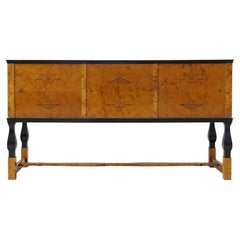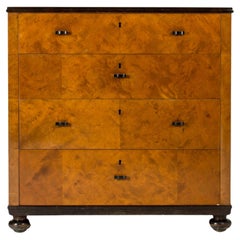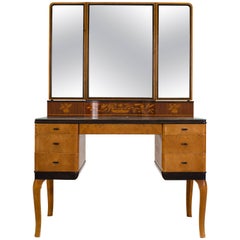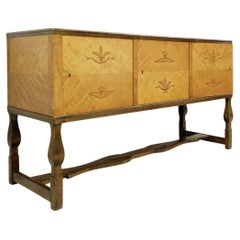Carl Malmsten Haga
Vintage 1930s Swedish Art Deco Commodes and Chests of Drawers
Birch
Vintage 1930s Swedish Scandinavian Modern Carts and Bar Carts
Birch
Recent Sales
Vintage 1930s Swedish Art Deco Vanities
Birch
Vintage 1930s Swedish Art Deco Buffets
Wood
Vintage 1930s Swedish Scandinavian Modern Vanities
Mirror, Wood, Birch
Vintage 1930s Swedish Scandinavian Modern Carts and Bar Carts
Birch
Vintage 1930s Swedish Scandinavian Modern Side Tables
Birch
Vintage 1920s Swedish Art Deco Sideboards
Birch, Oak
People Also Browsed
2010s Italian Modern Chaise Longues
Wood
Vintage 1970s Japanese Industrial Wall Lights and Sconces
Brass, Copper, Iron
2010s South African Minimalist Pedestals
Wood
21st Century and Contemporary Italian Mid-Century Modern Chandeliers and...
Brass
Vintage 1940s French Art Deco Dining Room Tables
Oak
Antique Mid-19th Century Swedish Country Dining Room Tables
Pine
2010s Danish Arts and Crafts Pillows and Throws
Fabric
21st Century and Contemporary Indian Side Tables
Aluminum
2010s Italian Organic Modern Wall Lights and Sconces
Brass
Antique 19th Century Swedish Biedermeier Dining Room Chairs
Birch
Mid-20th Century French Mid-Century Modern Dining Room Chairs
Rush, Wood
2010s American Mid-Century Modern Dining Room Tables
Walnut
20th Century Danish Scandinavian Modern Vanities
Teak
2010s American Modern Wardrobes and Armoires
Brass
Antique Mid-18th Century French Louis XV Bookcases
Oak
Late 20th Century French Modern Coffee and Cocktail Tables
Slate
Carl Malmsten for sale on 1stDibs
Carl Malmsten, a prominent furniture designer and educator associated with Swedish modernism, enjoyed immense popularity for his shapely sofas and armchairs in luscious color palettes. Malmsten believed that light — much like our eyes and bodies — doesn’t like to bump into sharp objects. Smooth edges, on the other hand, are kinder to the eye and and to our touch, and allow light to softly bounce off surfaces. Malmsten felt that if his furniture didn’t “serve well” in the home, it had no business being there.
Malmsten’s career essentially began in 1915, when his submissions for a competition to furnish the new Stockholm City Hall were first- and second-place prize winners. In the 1920s, his profile soared. He won a prize at the International Exhibition of Modern Decorative and Industrial Arts — the show that brought the Art Deco style to worldwide attention — and quickly became one of the most sought-after designers of commercial seating in Sweden.
Malmsten was soon contracted to design chairs, tables and other furniture for the Stockholm Concert Hall, the Swedish Institute in Rome and the Waldorf Astoria hotel in New York. His famous Art Nouveau-influenced Stadshusstolen chair, designed for Stockholm City Hall in 1916, is a highlight of the city’s recently opened Museum of Furniture Studies. Malmsten expanded into interior design and created a luxurious, well-appointed living room in the palace of then-Crown Prince Gustaf Adolf and his bride, Crown Princess Louise.
In the 1930s, Malmsten clashed with critics when he voiced his opposition to functionalism. Like Danish modernist Kaare Klint, he favored using quality local materials and prized traditional craftsmanship. Malmsten’s furniture draws on graceful neoclassical influences, and he said that extreme functionalism contributed to “sterile” interiors — while the curving contours of his work may share ground with furniture designed by Alvar Aalto or Bruno Mathsson, Malmsten differed with Bauhaus eminences and some Scandinavian modernists on their prioritization of functionalism.
For an exhibition in 1956 at the Röhsska Museum in Gothenburg, Malmsten designed furniture that was intended for mass production — and his striking designs began to make their way into middle-class Swedish homes owing to Malmsten’s partnerships with manufacturers such as O.H. Sjögren. Until then, he had built his pieces at the school he founded in the 1930s or had them made by artisans at several small local workshops.
Malmsten founded a number of schools for design and collaborated with other designers who shared his philosophy of “hand and mind in creative collaboration.” These included the esteemed textile artist Märta Måås Fjetterström, whose pieces he included in exhibits and even his own home.
On 1stDibs, find vintage Carl Malmsten seating, tables, cabinets and more.



